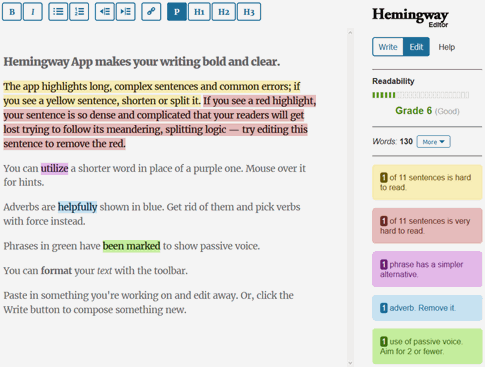Hemingway app forces you to write more simply
OR AT LEAST WITH SHORTER SENTENCES
If you are an academic, and you probably are if you read this blog, you may be interested in tools that improve writing. Recently, we stumbled upon the Hemingway Editor, a tool to encourage simple and forceful writing. It flags hard to read (i.e., long) sentences. It also flags adverbs, passive voice and unnecessarily complex phrases. We think that following all the editor’s advice would be a bad idea. Yet, using it for a few paragraphs on a paper reminds you to keep things simple. And it does, at least superficially, make you write more like Hemingway.
For fun, we applied it to one of our own abstracts below. It went from 145 words with grade 18 readability to 119 words with grade 14 readability.
You should beware, however, that readers may infer that simpler academic texts are of lower quality (Galak and Nelson, 2011).
REFERENCES
Galak, J. & Nelson, L. D. (2011). The virtues of opaque prose: How lay beliefs about fluency influence perceptions of quality. Journal of Experimental Social Psychology, Volume 47, Issue 1, January 2011, Pages 250–253
Goldstein, Daniel G., & David Rothschild. (2014). Lay understanding of probability distributions. Judgment and Decision Making, 9(1), 1-14.
Hemingway Editor: http://www.hemingwayapp.com/
BEFORE (145 Words. Grade 18 readability)
How accurate are laypeople’s intuitions about probability distributions of events? The economic and psychological literatures provide opposing answers. A classical economic view assumes that ordinary decision makers consult perfect expectations, while recent psychological research has emphasized biases in perceptions. In this work, we test laypeople’s intuitions about probability distributions. To establish a ground truth against which accuracy can be assesed, we control the information seen by each subject to establish unambiguous normative answers. We find that laypeople’s statistical intuitions can be highly accurate, and depend strongly upon the elicitation method used. In particular, we find that eliciting an entire distribution from a respondent using a graphical interface, and then computing simple statistics (such as means, fractiles, and confidence intervals) on this distribution, leads to greater accuracy, on both the individual and aggregate level, than the standard method of asking about the same statistics directly.
AFTER (119 Words. Grade 14 readability)
How accurate are laypeople’s intuitions about probability distributions of events? The economic and psychological literatures provide opposing answers. A classical economic view assumes that ordinary decision makers consult perfect expectations. Recent psychological research has emphasized biases in perceptions. In this work, we test laypeople’s intuitions about probability distributions. We control the information seen by each subject to establish unambiguous ground truth answers. We find that laypeople’s statistical intuitions are accurate but depend upon the elicitation method. We computed simple statistics from distributions elicited using a graphical interface. The statistics included means, fractiles, and confidence intervals. All statistics derived from distributions were more accurate than those obtained by direct asking. This was true on both the individual and group level.



This is great marketing — these tools have been part of Microsoft’s Word for a long time. But, call it “Hemingway app” and you really have something!
June 14, 2016 @ 8:15 pm
Love it! And I think it did mostly improve the abstract. But towards the end I think it got slightly less clear. I’d do it like this:
> … We compare two ways to elicit statistics such as means, fractiles, and confidence intervals. Of course you can ask for them directly. But we also tried eliciting the entire distribution with a graphical interface. Then you can compute any statistics from that. Doing so leads to greater accuracy, on both the individual and group level.
(The only violation is “directly”. Hemingway doesn’t like adverbs, I guess.)
Btw, I just added this to a draft of a similar post I’ve been nurturing for like a year: http://expost.padm.us/outloud
June 14, 2016 @ 8:37 pm
Readability is greatly improved.
June 14, 2016 @ 8:57 pm
Total waste of money. If you can recognize adverbs and passive voice on your own, then this app adds nothing. Examples of its pithy advice include replacing “obtain” with “get.”
June 15, 2016 @ 1:20 pm
I liked the first version with 145 Words and Grade 18 readability more. Neither the readability nor the understandability was better in the second case.
October 17, 2019 @ 8:47 am